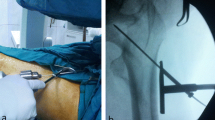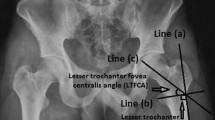Abstract
Introduction
Intertrochanteric fractures of femur are common in elderly patients. The compression hip screw has become the predominant method for osteosynthesis of intertrochanteric fractures. However, the conventional dynamic hip screws (CDHS) technique has some disadvantages. Recently, we have used a minimally invasive dynamic hip screws (MIDHS) technique to reduce these disadvantages. This prospective study is to compare curative effect of MIDHS with that of CDHS with open reduction on Evans type 1 intertrochanteric fractures.
Materials and methods
All 97 fractures were classified according to the Evans systems. The MIDHS group included 47 patients with an average age of 68.7 years, and the CDHS group included 50 patients with an average age of 68.7 years. The Singh index was used as a measure of osteoporosis.
Results
Both groups were similar in injury mechanism, fracture types, mean Singh index and medical diseases (all P > 0.50). All fractures were healed within 4 months in both groups except three cases who were implant failure and nonunion in the CDHS group. The MIDHS group had significantly smaller wound size, shorter surgery time, less blood loss, lower blood transfusion rate, earlier active mobilization of fractured hip joint, shorter hospital stay, lower serious complication rate and higher Harris hip score than the CDHS group (all P < 0.05). The satisfactory reduction, adequate screw position, healing time and union rate was not significantly difference between two groups (all P > 0.05).
Conclusion
When the fractures are treated adequately, either the MIDHS or the CDHS with open reduction is an effective and safe method, but the MIDHS is superior to the CDHS with open reduction for the treatment of Evans type 1 intertrochanteric fractures of femur.




Similar content being viewed by others
References
Adams CI, Robinson CM, Court-Brown CM, McQueen MM (2001) Prospective randomized controlled trial of an intramedullary nail versus dynamic screw and plate for intertrochanteric fractures of the femur. J Orthop Trauma 15:394–400
Audige L, Hanson B, Swiontkowski MF (2003) Implant-related complications in the treatment of unstable intertrochanteric fractures: meta-analysis of dynamic screw-plate versus dynamic screw-intramedullary nail devices. Int Orthop 27:197–203
Bolhofner BR, Russo PR, Carmen B (1999) Results of intertrochanteric femur fractures treated with a 135° sliding screw with a two-hole side plate. J Orthop Trauma 13:5–8
Brandt SE, Lefever S, Janzing HM, Broos PL, Pilot P, Houben BJ (2002) Percutaneous compression plating (PCCP) versus the dynamic hip screw for pertrochanteric hip fractures: preliminary results. Injury 33:413–418
DeLee JC (1991) Fractures and dislocations of the hip. In: Rockwood CA Jr, Green DP, Bucholz RW (eds) Rockwood and Green’s fractures in adult, 3 edn. Philadelphia, pp 1481–1651
Evans EM (1949) The treatment of trochanteric fractures of the femur. J Bone Joint Surg Br 31:191–203
Gotfried Y (2000) Percutaneous compression plating of intertrochanteric hip fractures. J Orthop Trauma 14:490–495
Hardy DCR, Descamps PY, Krallis P, Fabeck L, Smets P, Bertens CL, Delince PE (1988) Use of an intramedullary hip-screw compared with a compression hip-screw with a plate for intertrochanteric femoral fractures: a prospective, randomized study of one hundred patients. J Bone Joint Surg Am 80:618–630
Haynes RC, Pöll RG, Miles AW, Weston RB (1997) Failure of femoral head fixation: a cadaveric analysis of lag screw cut out with the gamma locking nail and AO DHS. Injury 28:337–341
Ingman AM (2000) Percutaneous intramedullary fixation of trochanteric fractures of the femur: clinical trial of a new hip nail. Injury 31:483–487
Jensen JS, Sonne-Holm S, Tondevold E (1980) Unstable trochanteric fractures: a comparative analysis of four methods of internal fixation. Acta Orthop Scand 51:949–962
Jones HW, Johnston P, Parker M (2006) Are short femoral nails superior to the sliding hip screw? A meta-analysis of 24 studies involving 3279 fractures. Int Orthop 30:69–78
Kim WY, Han CH, Park JI, Kim JY (2001) Failure of intertrochanteric fracture fixation with a dynamic hip screw in relation to pre-operative fracture stability and osteoporosis. Int Orthop 25:360–362
Lee YS, Huang HL, Lo TY, Huang CR (2007) Dynamic hip screw in the treatment of intertrochanteric fractures: a comparison of two fixation methods. Int Orthop 31:683–688
Lorich DG, Geller DS, Nielson JH (2004) Osteoporotic pertrochanteric hip fractures management and current controversies. J Bone Joint Surg Am 86:398–410
Mariani EM, Rand JA (1987) Nonunion of intertrochanteric fractures of the femur following open reduction and internal fixation: results of second attempts to gain union. Clin Orthop Relat Res 218:81–89
O’Brien PJ, Meek RN, Blachut PA, Broekhuyse HM, Sabharwal S (1995) Fixation of intertrochanteric hip fractures: gamma nail versus dynamic hip screw—a randomized prospective study. Can J Surg 38:516–520
Sawaia RN, Belangero WD (2008) The treatment of transtrochanteric fractures of the femur with a minimally invasive technique using an extramedullary implant MINUS system. Int Orthop 32:159–165
Seibert FJ, Schippinger G, Szyszkowitz R (1997) Invited commentary to: “gamma nail vs. dynamic hip screw in 120 elderly patients—a randomized trial”. Acta Chir Aust 29:294–295
Shah MR, Aharonoff GB, Wolinsky P, Zuckerman JD, Koval KJ (2001) Outcome after hip fracture in individuals ninety years of age and older. J Orthop Trauma 15:34–39
Singh M, Nagrath AR, Maini PS (1970) Changes in trabecular pattern of the upper end of the femur as an index of osteoporosis. J Bone Joint Surg Am 52:457–467
Sommers MB, Roth C, Hall H, Kam BC, Ehmke LW, Krieg JC, Madey SM, Bottlang M (2004) A laboratory model to evaluate cutout resistance of implants for pertrochanteric fracture fixation. J Orthop Trauma 18:361–368
Stern R (2007) Are there advances in the treatment of extracapsular hip fractures in the elderly? Injury 38(Suppl 3):S77–S87
Author information
Authors and Affiliations
Corresponding author
Additional information
This study was conducted at West China Hospital, Sichuan University, Chengdu, People’s Republic of China and Central Hospital of Panzhihua, Sichuan Province, People’s Republic of China. The authors have not received and will not receive any financial benefit in association with the present paper.
Rights and permissions
About this article
Cite this article
Wang, JP., Yang, TF., Kong, QQ. et al. Minimally invasive technique versus conventional technique of dynamic hip screws for intertrochanteric femoral fractures. Arch Orthop Trauma Surg 130, 613–620 (2010). https://doi.org/10.1007/s00402-009-0978-6
Received:
Published:
Issue Date:
DOI: https://doi.org/10.1007/s00402-009-0978-6




